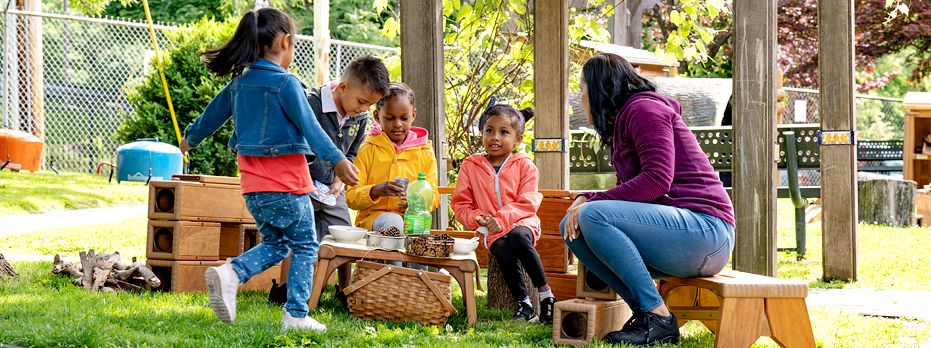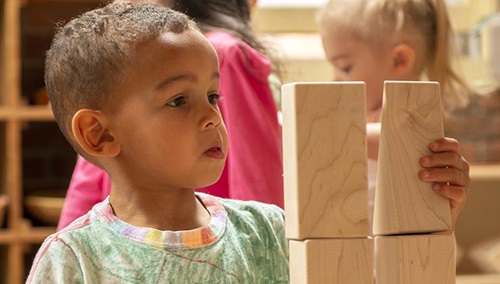Play: Priceless
| May 2009Go to Your Happy Place
Ask any adult to think of a happy childhood memory and most likely it will involve play. Their mental picture will probably look something like this: playing hide-and-seek, climbing a tree, building a fort, digging for worms, or putting on a “show” with friends. And ask any adult if they would rather work or play and almost certainly they would choose play. For the majority of adults, play and work are completely separate; for children, it is one and the same. This is the crux of a never ceasing problem; many adults do not view children’s play as important. They do not see the connection between playing and learning. Could this be why, sadly, children today are slowly but surely losing opportunities for precious and critically important experiences?
History of Free-Play Reduction
Childhood is an enchanting and wondrous time that should be respected and cherished. Play is an extremely important element of children’s healthy development. In fact, it is so important that in November of 1959 the United Nations High Commission for Human Rights recognized it as a right of every child. Yet, during the past several decades, free-play has drastically been reduced. Creative, open-ended, free-play is rapidly disappearing from our homes, our schools, and our communities. What has caused a decline in free-play? The cause is complex but many factors include: pop culture, changes in family structure, hurried lifestyles, unsafe neighborhoods, technology, and an increased focus on student achievement. According to a study by Sandra Hofferth at the University of Maryland, over the last two decades children have lost eight hours of unstructured, spontaneous free-play a week, and more than 30,000 schools have eliminated recess to make more time for academics. In a mere six years, from 1997 to 2003, the time children spent outdoors fell 50 percent. Hofferth also found that the amount of time children spend in organized sports doubled, and the number of minutes children spend each week being passively entertained has increased from 30 minutes to more than three hours.
According to Howard Chudacoff, a cultural historian at Brown University, a historical pivot point in play happened in 1955, when the Mickey Mouse Club debuted on television. That same year, the Mattel toy company started to advertise their wares on television outside of the holiday season, a first of its kind. Practically overnight, children's play became focused on things (toys) and passive entertainment (television.) "It's interesting to me that when we talk about play today, the first thing that comes to mind are toys," says Chudacoff. Play in the 19th century typically consisted of physical activity and the use of imagination. Today, children are playing with more specific, close-ended toys that have pre-planned purposes. Essentially, instead of playing with cardboard boxes, creating make-believe cars, children are riding in miniature electric vehicles that resemble mom’s SUV. Chudacoff refers to this as the commercialization and co-optation of children's play and believes that it is reducing children's creative aptitude. Diane Levin, a child development expert at Wheelock College in Boston states that "Developing imagination and creativity is essential for children to develop problem-solving skills.'' She believes that as a result of free-play reduction, children are developing a "problem-solving deficit disorder”.
Play or Pay
Psychologists believe that changes in children’s play have negatively impacted cognitive and emotional development. Because children’s activities are now more regulated by adults, children are not able to practice regulating them. Self-regulation is a crucial developmental task. Developmental neuroscience research provides evidence that free-play actually helps children develop a critical cognitive skill called executive function. The brain’s executive function has many features, the central one being the ability to self-regulate. Children who have good self-regulation are able to control their emotions and behavior, resist impulses, and exert self-control and self-discipline. A poorly developed executive function is associated with high dropout rates, drug use and crime.
Laura E. Berk, Professor of Psychology at Illinois State University, studies self-regulation and private speech. According to Berk, one reason make-believe play is such a powerful tool for building self-discipline is because during make-believe, children engage in what is called private speech. Children talk to themselves about what they are going to do and how they are going to do it. "In fact, if we compare preschoolers' activities and the amount of private speech that occurs across them, we find that this self-regulating language is highest during make-believe play," Berk says. "And this type of self-regulating language… has been shown in many studies to be predictive of executive functions." Berk explains that private speech is used to overcome obstacles, to master cognitive and social skills, and to manage emotions. Unfortunately, the more structured the play, the less private speech children exhibit.
If you look up “child’s play” online at www.thefreedictionary.com, there are two definitions: “something very easy to do” and “a trivial matter”. Spontaneous, open-ended, free play is easy to do but it is hardly trivial. The latter definition may sum up what parents (and some educators for that matter) think about play: that it is unimportant and pales in comparison to academic instruction. Many early childhood programs and parents have good intentions but these good intentions may be having the opposite effect. According to Anne Haas Dyson, a University of Illinois professor who studies childhood learning and literacy development, “Parents and educators who favor traditional classroom-style learning over free, unstructured playtime in preschool and kindergarten may actually be stunting a child’s development instead of enhancing it”. Studies that compared the performance of children attending academic preschools with those attending play-based preschools showed no advantage in reading and math achievement for children attending academic preschools. However, evidence did suggest that children attending academic preschools had higher levels of test anxiety, were less creative, and had more negative attitudes toward school than did the children attending play-based preschool.
Reflecting on Play
Deeper discussions about play need to take place in order for a paradigm shift to occur. We can begin to do this by examining our current beliefs about play, asking ourselves thought provoking questions, and reflecting on our own childhood:
- How do you view play?
- Do you believe children are learning while engaging in free-play?
- Do you know what effect play has on the architecture of the developing brain?
Perhaps by examining our own childhood play experiences, we can examine how we view children's play and how much regard we have for it. Anette Sandberg, Senior Lecturer at Malardalens University in Sweden, conducted a study focused on preschool teachers' conceptions of play. She stated, “it is astonishing that educated preschool teachers have not thought about the relationship between their own childhood experiences and how they think about children's childhood experiences today”. One teacher who participated in the study stated that she did not give play much thought until she was interviewed. After reflecting, she realized that play had influenced her childhood much more than she had previously understood.
Conclusion
Our society needs to consider play as having pedagogical value. Educators need to provide children with more free-play opportunities and educators need to educate parents on the importance of play. We must advocate for the “Right to Play” established 50 years ago. The demands of the 21st century will require creative minds. According to Sharna Olfman, a psychology professor at Pittsburgh's Point Park University who has studied children's imaginative play, "Many of our greatest thinkers locate their capacity for original and profound thought in their imaginative abilities, first developed through creative play in early childhood.'' Olfman believes that if children do not develop an ability to think creatively, they will mature into adults who lack the capacity to innovate—in business, government and their personal lives.
References and Resources:
Elkind, D. (2008, Spring). Can we play? Greater Good Magazine Volume IV, Issue 4 Retrieved April 17, 2009 from: http://greatergood.berkeley.edu/greatergood/2008spring/Elkind344.html
Gray, P. (2008, December 16). Freedom to Learn: The value of play III: children use play to confront, not avoid, life’s challenges and even life’s horrors. Psychology Today web log. Retrieved April 17, 2009 from: http://blogs.psychologytoday.com/blog/freedom-learn
MacPherson, K. (2004, August 15) Experts concerned about children's creative thinking. Post-Gazette National Bureau. Retrieved April 17, 2009 from: http://richardsinstitute.org/UserFiles/experts_concerned_about_children.pdf
Marantz Henig, R. (2008, February 17). Taking play seriously. The New York Times. Retrieved from: http://www.nytimes.com
Sandberg, A. & Pramling Samuelsson, I. (2003, Spring). Preschool Teachers' Play Experiences Then and Now. Early Childhood Research & Practice. Vol. 5 No. 1
Spiegel, A. (2008, February 21). Old-Fashioned Play Builds Serious Skills. National Public Radio. Retrieved April 17, 2009 from: http://www.npr.org/templates/story/story.php?storyId=19212514
University of Illinois at Urbana-Champaign. (Feb. 12, 2009). All Work And No Play Makes For Troubling Trend In Early Education. Science Daily. Retrieved April 17, 2009 from: http://www.sciencedaily.com/releases/2009/02/090212125137.htm






